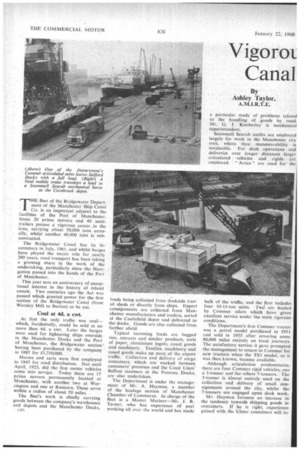• Vigorot ',ole for Canal
Page 84

Page 85

If you've noticed an error in this article please click here to report it so we can fix it.
rehicles
By Ashley Taylor, A.M.I.R.T.E.
THE fleet of the Bridgewater Department of the Manchester Ship Canal Co. is an important adjunct to the facilities of the Port of Manchester. Some 20 prime movers and 40 semitrailers pursue a vigorous career in the area, carrying about 50,000 tons annually, whilst another 40,000 tons is subcontracted.
The Bridgewater Canal has its bicentenary in July, 1961, and whilst barges have played the major role for nearly 200 years, road transport has been taking a growing share in the work of the undertaking, particularly since the Navigation passed into the hands of the Port of Manchester.
This year sees an anniversary of exceptional interest in the history of inland canals. Two centuries ago the Act was passed which granted power for the first section of the Bridgewater Canal (from Worstcy Mill to Barton) to be cut.
Coal at 4d, a cwt.
At first the only traffic was coal— which, incidentally, could be sold at no more than 4d. a cwt. Later the barges were used for lightening ships overside in the ManchesterDocks and the Port of Manchester, the Bridgewater section having been purchased by the company in 1885 for £1,710,000.
Horses and carts were first employed in 1845 for road distribution. Not until April, 1923, did the first motor vehicles come into service. Today there are 17 prime movers permanently located at Manchester, with another two at Warrington and one at Runcorn. These serve within a radius of about 50 miles.
The fleet's work is chiefly carrying goods between the company's warehouses and depots and the Manchester Docks, c46 loads being collected from dockside transit sheds or directly from ships. Export consignments are collected from Manchester manufacturers and traders, sorted at the Castlefield depot and delivered to the docks. Goods are also collected from farther afield.
Typical incoming loads are bagged rice, extracts and similar products, reels of paper, aluminium ingots, cased goods and machinery. Textiles, machinery and cased goods make up most of the export traffic. Collection and delivery of cargo containers, which are worked between customers' premises and the Coast Lines' Belfast steamers at the Pomona Docks, are also undertaken.
The Department is under the management of Mr. A. Hayman, a member of the haulage section of Manchester Chamber of Commerce. In charge of the fleet is a Master Mariner—Mr. J. R. Turner, who has experience of port working all over the world and has made
a particular study of problems related to the handling of goods by road. Mr. G. J. Kimberley is mechanical superintendent.
Scamrnell Scarab outfits are employed largely for work in the Manchester city area. where their manceuvrability is invaluable. For dock operations and deliveries over longer distances larger articulated • vehicles and rigids arc employed. " Artics are used for the
bulk of the traffic, and the fleet includes four 10-11-ton units. Twd arc hauled by Commer oilers which have given excellent service under the most rigorous conditions.
The Department's first Commer tractor was a petrol model purchased in 1951 and sold in 1955 after covering some 80,000 miles entirely on local journeys. The satisfactory service it gave prompted the management to return to Commer for new tractors when the TS3 model, as it was then known, became available.
Although articulation predominates, there are four Commer rigid vehicles, one a 3-tonner and the others 7-tonners. The 3-tonner is 'almost entirely used on the collection and delivery of small consignments around the city, whilst the 7-tonners are engaged upon dock work.
Mr. Hayman foresees an increase in the tendency towards shipping goods in containers. If he is right, experience gained with the Ulster containers will be
of obvious value and might well gain more traffic. Other vehicles include a Thames Trader 7-tonner, three Bedford 10-ton tractors, seven Scarnmell 6-ton mechanical horses, a Bedford light van, 15 10-ton and 20 6-ton semi-trailers and a pole trailer.
Common practice with " artics" is to leave semi-trailers for loading at customers' premises while the tractors deliver with laden units, later bringing in empty semi-trailers and taking away the loaded ones. Annual vehicle mileages range up to 18,000, according to the nature of the traffic carried. Total fleet mileage for a typical year is approximately 125,000.
Some of the Department's warehouses in Manchester were destroyed in 1940 and have been replaced by extensive single-storey sheds. These establishments provide general storage accommodation from which road services are operated. There is now a capacity of about 50,000 tons, in addition to ample space for outside storage of timber. Fork-lift trucks of various types, mobile cranes and other appliances assist loading.
At Runcorn there are 14 warehouses with a total capacity of 30,000 tons, plus open storage. Mobile cranes and similar equipment are extensively used there too. There is also warehousing and storage space at Howley Quay, on the Mersey. and at Warrington. The Department exercises control over the fleet from Castlefield, Manchester, in close liaison with company dock and warehouse offices. Vehicles in the Warrington area are directed by: the Howley Quay offices, 'subject, to overriding eontrol from Manchester.
Comprehensive costing calculations are made so that figures per mile, hour and ton can be assessed. A tonnage bonus is applied to certain regular traffic, and another incentive to workers is a return.load-bonus system.
Maintenance is done by the mechanical engineer's section, which is responsible for all lubrication, repairs and overhauls. Calculations -are based on time for the smaller vehicles engaged upon local work and mileage for the other vehicles in accordance with makers' recommendations. The extensive and well-equipped workshops have recently been renovated. Full vehicle histories are kept in the road transport office, whilst individual maintenance logs are in the charge of the engineer.












































































































































